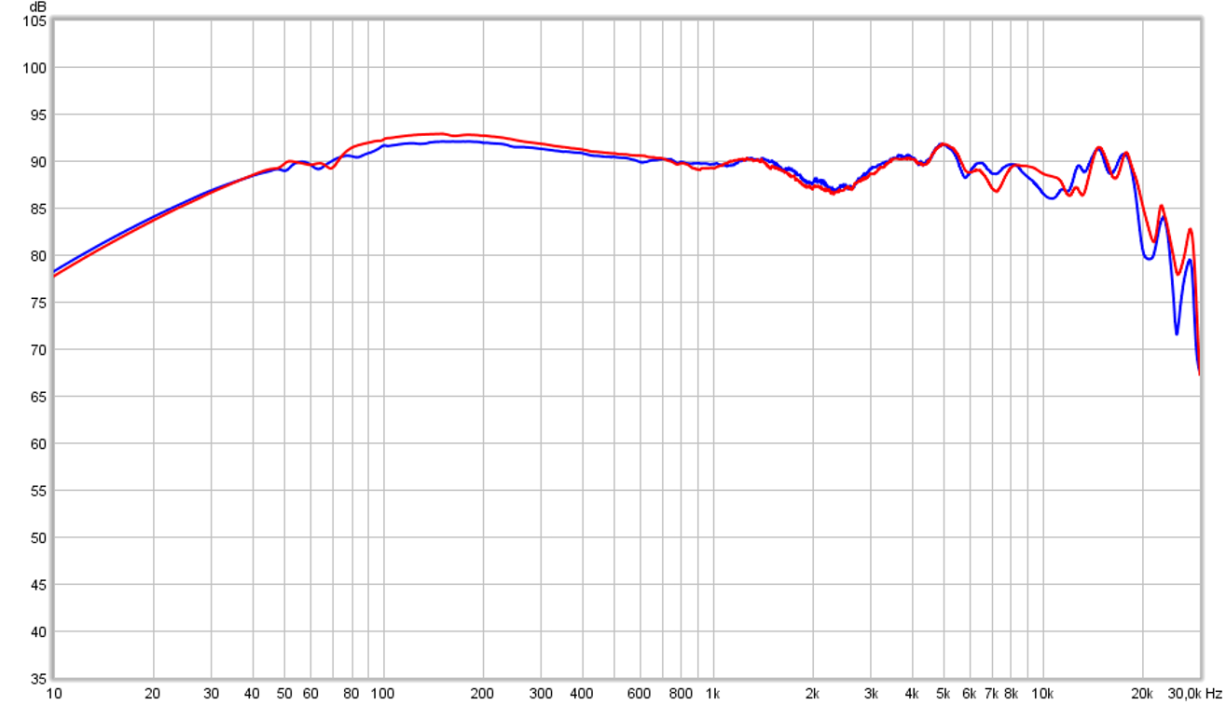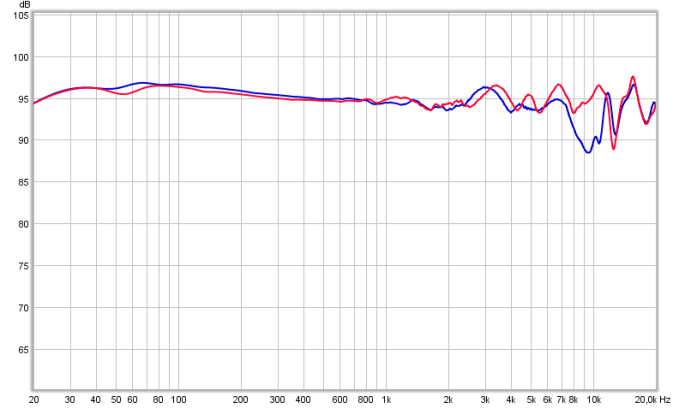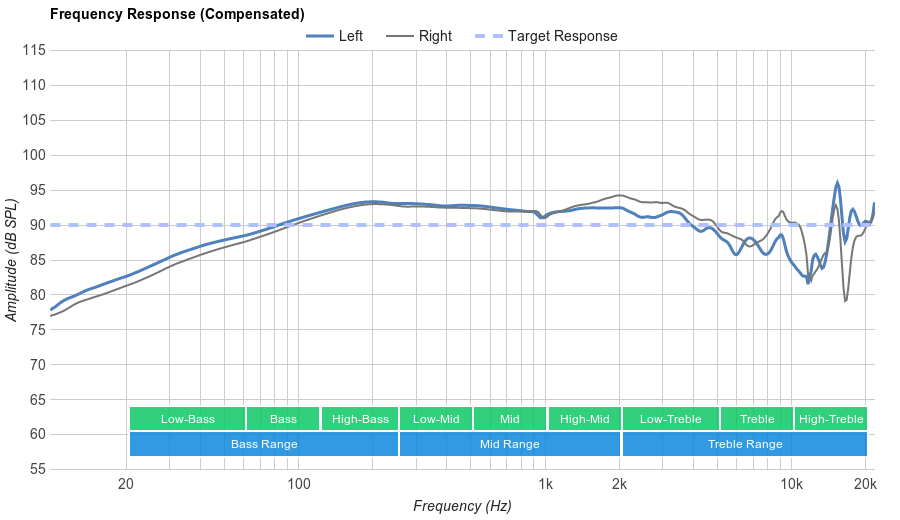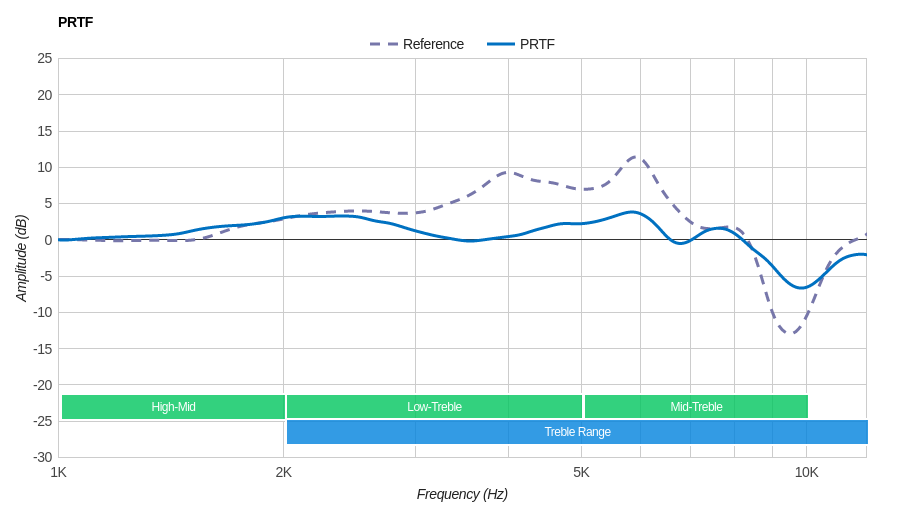As a comparison here is my measurement of a recent HD650 (its compensated in the lows)
A horizontal line is 'audible flat' to at around 70-80dB SPL.
In your case the blue line is audible flat.
This is how they sound to me as well (at that volume). Somewhat lacking in the subbass apartment with a hint of 'warmth'(hump around 150Hz) and not needing any correction at all in the mids and treble.
That is indeed why it is universally loved and still today is one of the most neutral headphones.
Add to that there is virtually no Pinna activation which means that ear shape etc. has little influence on the perceived SQ
Downside (which does not show) is the 'narrow' headstage it has but does not bother me.
When I EQ mine (an older HD650) it measures like this:
Note: the frequency limits and sizing of the plots differ.
The realism is scary. There is a great rumble, not artificial warmth but just enough and the treble is sparkly, detailed and subdued with plenty of 'air' but not 'ethereal' sounding nor 'hyper-detailed', just the right amount.
Let's analyze some more and welcome everyone in the world of '
measuring headphone science' (the call for a standardization plea ?)
When looking at your plot I would conclude the HD650 is 'flat' down to 30Hz (for me it is 50Hz almost one octave higher)
Around 150Hz you have about +2dB which is the same as mine.
Both are on reference at 1kHz.
There is an obvious difference around 2.5kHz where I measure -3dB and you measure +4dB so a 7dB discrepancy.
This is obviously a Concha effect which you measure and I don't.
Knowing the Concha can make a difference I always 'listen' to headphones as well to determine whether or not a dip in that area is audible or not. That part of the frequency band is where 'presence/clarity' in sound is. Not to be confused with 'forward' sound which is at a lower band around 2kHz. The plot below shows what I think something sounds like when those bands are pushed up or down on an equalizer when coming from 'neutral = realistic' sound.
Let's take other measurers plots (everyone has measured a HD650) and let's use those with real HATS (with Pinnae) and that applied compensation already.
Below
Sam Vafei's (Rtings) attempt
Interestingly his measurement shows no bass extension at all, it has some to me, just not the rumble on the correct level.
His measurements show a drop off from the 150Hz point and is 3 octaves higher than mine.. seems incorrect to me.
At 30Hz he is at -7dB, I am -3dB and yours is 0dB. But his measurements (with Pinna) also show +1 to +3dB.
Here are his 'without Pinna' measurements (which is referenced to the horizontal grey line) and 'with Pinna" measurements (the blue line) which show the Pinna effect (the grey dotted is his 'target' curve) and around 2.5kHz he measures +4dB on Pinna activation.
When I would add that to my measurement it would show +1dB at 2.5kHz. It is why I don't compensate at all in that area in my EQ.
When you would compensate to the blue line you would end up with a -1dB dip there (a small dip is preferred over a small peak)
Tyll (
innerfidelity in its better years), unfortunately, applied the wrong compensation (above 1kHz) from day one and kept using it till he resigned as to keep the plots comparable.
His plots thus not reflect a horizontal line as 'flat' above 1kHz.
I drew in a 'reference' line (in green) and when you de-tilt that green line to a flat line it displays the perceived tonal balance better.
My green line is to be viewed as your blue line. The green line is not the exactly correct line as all of his plots show a peak at 10kHz which is incorrect but it is closer to the truth.
His plots show 40Hz (at 1kHz ref) which is nicely between ours.
He too has a +2dB hump at 150Hz and references to 1kHz. At 3kHz he also has a small bump (look at de-tilted plot below the real plot)
At 10kHz he has a peak of around +3dB where non of us have this it should be just below 1kHz level as all our plots show.
Above 10kHz things are not reliable anymore with a Pinna. Mine is measuring the driver response directly and think is 'more trustworthy' as there are no Pinna interactions.
Below the attempt of our Russian friends (
RAA) using a HATS
It starts to drop off (with respect to 1kHz) at 50Hz and has a +2.5dB hump at 150Hz. At 2.5khz it shows -1dB.
The weird part (and is why I think their compensation is really 'off') is that at 5kHz it measures +6.5dB !
That would make it terribly sibilant which it is not at all.
A -10dB dip at 10kHz also seems awfully wrong.
Headroom uses Tyll's data but with better compensation (at least when set to '
frequency response compensated' and '
20dB')
http://graphs.headphone.com/graphCompare.php?graphType=-1&graphID[]=853&scale=20
(direct links are not allowed ?)
Extends to 22Hz (ref 1kHz) which I don't believe it does, and shows a +5dB hump around 150Hz (which also is not real) and -1dB around 2.5kHz
Around 0dB at 10kHz (the Tyll rig peak is clearly visible)
Below
Golden Ears....
http://en.goldenears.net/en/files/attach/images/254/616/011/3c7a27dace4e4c6da9f3fc979f578d01.png
(direct links are not allowed ?)
Let's not use their green line as reference, but the measured response.
30Hz = 0dB opposite 1kHz. A +3dB hump around 150Hz, 0dB at 2.5kHz (with Pinna) and -1dB at 10kHz
When using their target response (quite similar to mine and Sonarworks's) we get different numbers.
100Hz = 0dB opposite 1kHz. A +2dB hump around 300Hz !, 0dB at 2.5kHz (with Pinna) and -1dB at 10kHz
Next up is
Sonarworks, in this case not an averaged plot but an individual one.
50Hz = 0dB ref 1kHz, 150Hz hump = +2dB, 2.5khz = -1.5dB, 10kHz = +3dB and interestingly enough +3dB at 6kHz ?
Of course there are plenty of other plots around.
On
SBAF for instance there are loads of measurements from different 'measurebators' but won't post any of their plots here to avoid nasty reactions. But feel free to look around there.
And let's not forget
Jude Mansilla (Head-fi)... (gray dashed line, the blue line = HD6XX which is HD650)
50Hz = 0dB ref 1kHz, 150Hz hump = +3.5dB, 2.5kHz = -3dB, 5.5kHz shows a +3dB peak, 10kHz = -7dB but veers up again above it to 0dB (like mine are)
I am convinced that the production spread is very small so all measured differences come from differences in measurement rigs and or compensations applied.
As can be seen in this analysis individual measurements differ several dB's depending on the rigs.
If one were to apply an FR compensation to measure 'flat' within 1dB we would get substantially different sounding headphones as a few dB is quite audible where as when no compensation (based on measurements) would be applied they would all sound the same to the same individual.
The reason people perceive them different (from warm and subdued treble to neutral to bass shy and too forward) is personal preference and not HRTF based IMO. The same reason as why some find the AQ Nighthawk realistic and others find it bloated fat and dark.
Could be seal issues of course but not with the HD650.. I digress.
My point of view here is the following. Basing 'exact' EQ on measurements is flawed simply because of variances in measurement rigs.The HD650 is the most measured headphone in the world and 'exact' compensations aren't recommended when you look at the analysis above.
And remember most are from calibrated and compensated expensive HATS with prof equipment.
What I do see however is a clear correlation between all measurements. In my opinion one should thus not compensate 'exactly' acc. to measurements (as one compensates to the flaws of the rig which are compensated rather than the actual response) BUT must look at the great picture and apply some 'gentle' and average EQ in the area's which need improvement.
Remember, when actively 'compensating' narrow peaks and dips we also get ringing in the audible band.
So IMO a little subbass boost (a few dB) say below 50Hz as that's where the average seems to be (and mine are) and lower the midbass hump (around 150Hz) which all seem to show but in varying levels so around -2dB perhaps with the same bandwidth as all plots show.
I don't think around 2.5kHz nor at 5-6kHz any action should be taken when averaging all plots nor at 10kHz.
All in all that is all that seems needed and exactly what I apply (
Analog EQ, not digital).
Now apply this 'knowledge' to all other headphones and realize that the Pinna effect varies (thus between 2kHz and 5kHz) greatly between measurement rigs and different headphones and you could come to the conclusion that only some 'mild' overall compensation and perhaps the largest peaks (sibilance area 6-8kHz) need compensation seems the best way.
Personally, I think Schrodingers method isn't as bad but stands and falls with the SPL at which it is done and is individual as hearing damage is also included.
end of rant... sorry for the excess in words.











